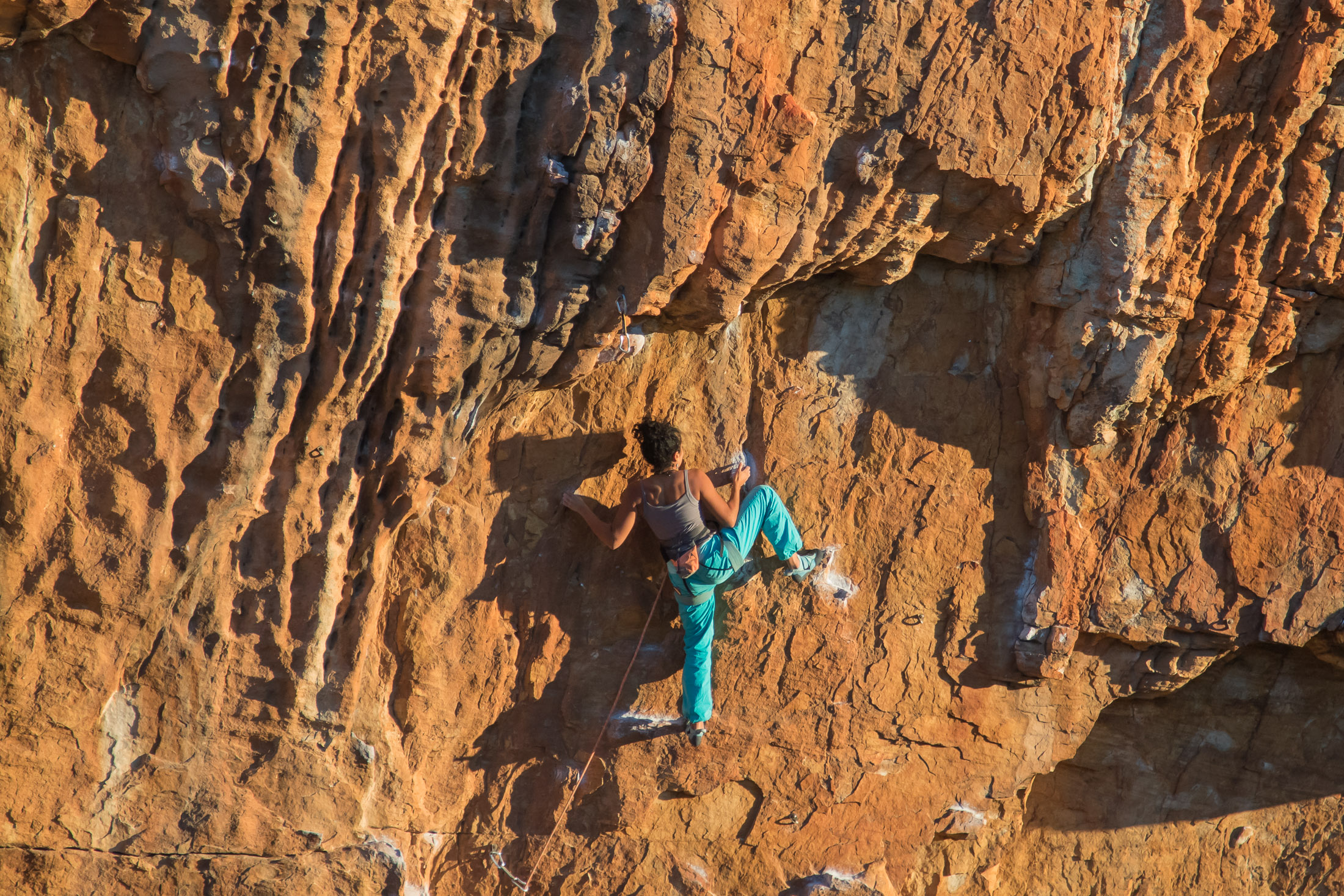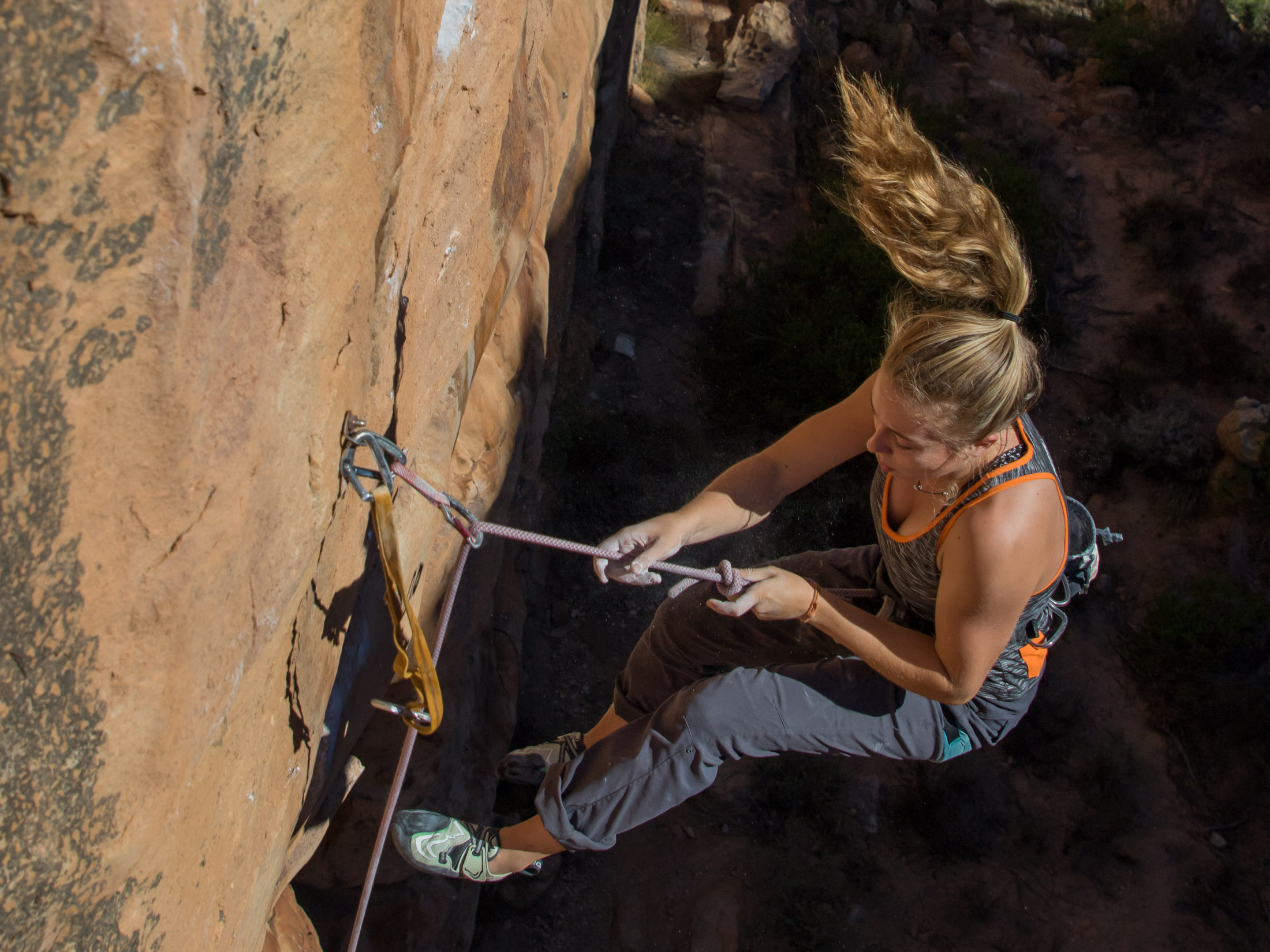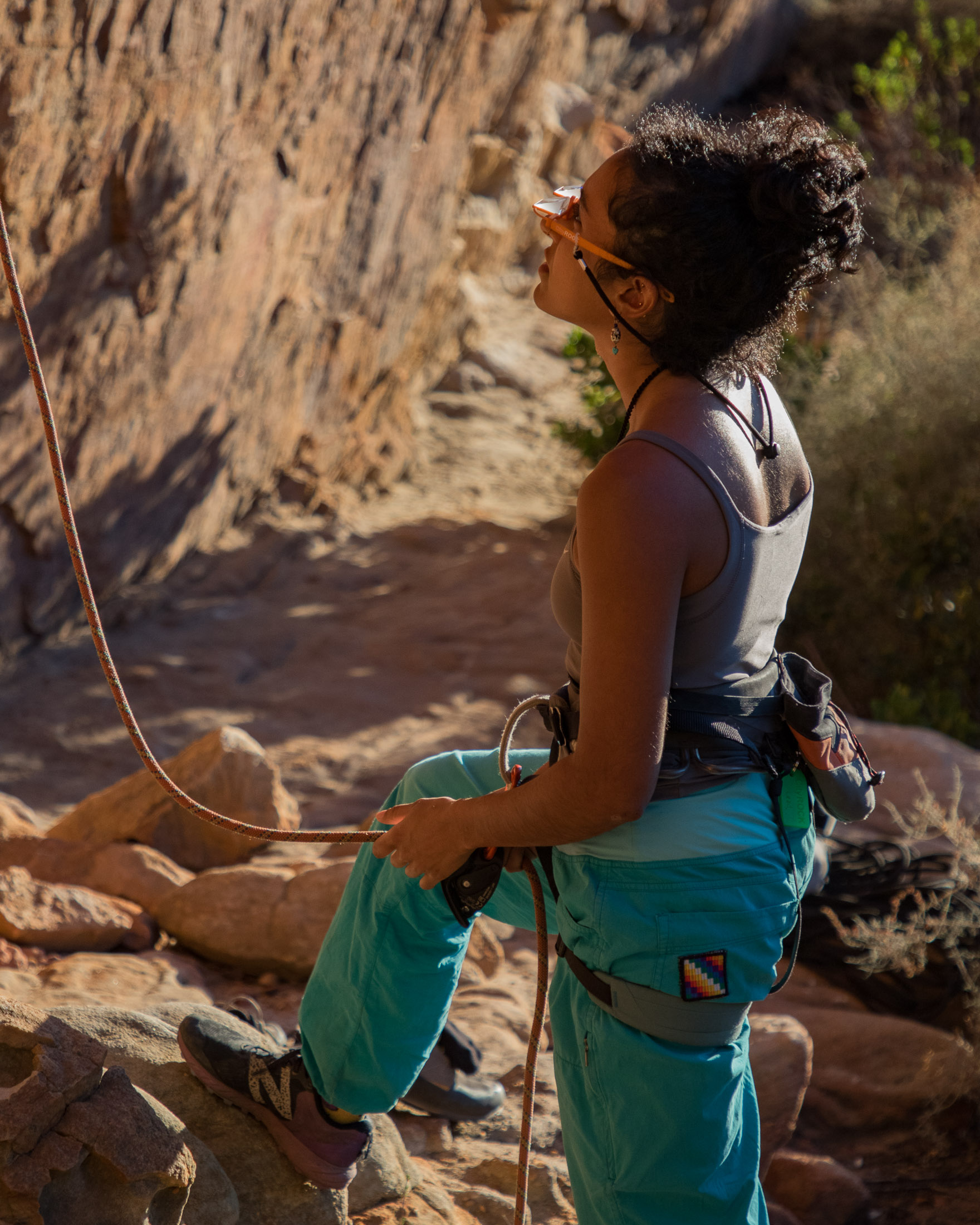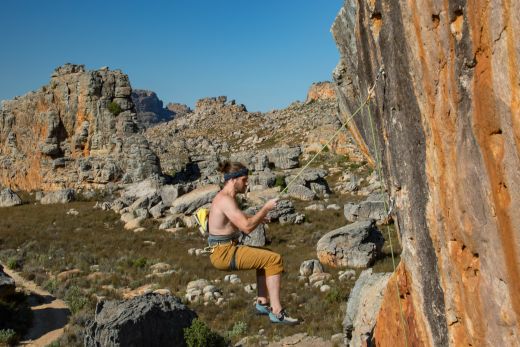In his book Nine Out of Ten Climbers Make the Same Mistakes, Dave MacLeod describes the fear of falling as the most significant thing holding back most climbers. I couldn’t agree more. Unfortunately, if you haven’t already overcome the fear of falling yourself, it’s hard to understand the extent to which climbing without fear can improve your performance and make your whole climbing experience more enjoyable. You’re just going to have to take my word for it that this will be one of the best investments in time, energy and emotion that you ever make as a climber.
- Why overcome a fear of falling?
- Before you start
- A 4-step progression plan
- Tips for overcoming a fear of falling
Why overcome a fear of falling?
You might think that the answer is obvious – You don’t want to fear falling anymore. But the benefits of overcoming a fear of falling go beyond the emotional component. When you climb scared – as you do when you have a fear of falling – it’s all too easy to overgrip and move mechanically, habits which quickly rob you of energy and bring on a debilitating pump. Climbing without that fear allows you to loosen your grip and climb more dynamically and with greater fluidity – movement habits that will allow you to climb with greater efficiency and crush crux sequences that you might think are beyond your ability. And then of course, there is the fun factor. It’s just easier to enjoy yourself when you’re not scared all the time.
Before you start
Before we get into the 4-step progression plan, there are a few things you should learn or do first.
Learn to identify bad falls from safe falls
There are two ways to mitigate the risk of a bad fall when lead climbing. The first is to ensure that you don’t get a foot or leg caught behind the rope in a fall – a mistake that could result in you being flipped upside down (more about this in a minute). The second involves being able to identify no-fall zones – places you really don’t want to fall. Rock routes can have potential ground falls, run-outs, and ledges, and it’s important that you are able to identify these risks so that you can make informed decisions according to the level of risk acceptable to you. Being able to do this takes experience, something you won’t have if you’re new to climbing, but you can also ask more experienced partners to point out such hazards.
Recruit an experienced belayer
Getting comfortable with falls starts with learning to trust your belayer. At the very least, you should be confident that he or she is attentive and will catch you when you fall – even if not very softly. If your partner is easily distracted, you might need to explain what you expect from them when it comes to belaying. You can even make it a collective effort: ‘I feel that if we work on our belaying, we will climb with more confidence.’ If that results in no improvement, you could consider upgrading. A more experienced and attentive belayer will know how to give a soft catch and will be able to point out potentially dangerous falls.
Learn how to identify and give a soft catch
If your falls up until now have been jarring and unpleasant experiences, it might be because your belayers didn’t know how to give a soft catch. What is a soft catch exactly? It’s a fall in which the belayer slows the falling climber gradually over several meters. This technique ensures that the climber comes back into the wall more gently than they would if the belayer brought them to an abrupt stop. To soften a catch, a belayer gives a little jump just as the rope – with a plummeting climber on the other end – goes tight. Having already imparted some energy to overcome gravity and inertia, the belayer is lifted off the ground as the energy in the fall is dissipated.
It’s important to learn this skill not only so that you can reciprocate when you’re given a good belay but also so that you can explain to less experienced belayers how to give a soft catch. Just bear in mind that for you to be able to give a soft catch, there has to be space for a climber to fall into. This means that you’ll usually only employ this technique once your climber is several meters off the deck, and even then you will still need to be wary of ledges and other obstacles that your climber could fall into. Also note that the weight difference between the belayer and climber needs to be considered. If the climber is significantly heavier than the belayer, the latter needs to do very little to get airborne.
Know how to fall properly
Of course, a safe fall is not solely the responsibility of the belayer. The climber also has to do their part to mitigate the risk of a bad fall. For the most part, this means making sure that the rope doesn’t wander behind a leg or foot and flip you upside down during a fall. Always be aware of where your rope is relative to your feet, especially when traversing or climbing diagonally through steep terrain. If you can just manage that – avoid tangling a limb in the rope – you will significantly reduce the chances of a dangerous fall. Beyond this precaution, it helps to focus on keeping your body relaxed as you fall. This will help to soften your impact with the wall and avoid injury.&
Don’t push off unless you have to
In some circumstances, you might need to clear a ledge or some other obstacle. The usual tactic here is to push off slightly as you start to fall. This is a more advanced and slightly risky technique, so you should only employ it when you have to. Pushing off the wall when you don’t need to will only result in you falling in a deeper arc and coming back into the wall harder than if you fell straight down. It’s also important that you let your belayer know if you plan to do this as they will ensure that you have enough rope to fall clear of whatever it is you want to miss.
A 4-step progression plan for overcoming a fear of falling
Most climbers do some kind of falling practice when they first learn to lead. However, unless they have a very good coach or mentor, this usually isn’t done in a structured way conducive to overcoming a fear of falling. The standard introduction to falling is to simply have the new leader climb a meter or two above their last bolt and then fall. While some climbers are comfortable with diving straight in like this, most aren’t. The average new leader (or experienced climber who has a fear of falling) benefits far more from a progressive approach in which the ante is upped incrementally as their comfort zone expands.

Note: Most climbers do their falling practice in the gym, but you can also do this outside on a safely bolted route that has clean falls.
Step 1: top-rope falls
To start off, you are going to climb as high as the third or fourth bolt and then down climb a few moves so that you are about head level with the bolt. At this point, you are actually on a short top-rope and are completely safe – the perfect place to take your first fall from. Ask your belayer to give you a little slack and then let go. If this feels almost too easy, great. Do it again, but this time ask your belayer to give you a soft catch. If your belayer is only just starting to learn how to soften a catch, this will be good practice for them. The timing of the belayer’s jump has to be even more precise when there is only a little slack in the system. Repeat this process a third and fourth time with a little extra rope in the system.
Step 2: small lead falls
Once you are comfortable taking falls from below the bolt, climb a move or two higher so that you are level with the bolt, and fall again. Again, you belayer should aim for a soft catch. If any of the catches are jarring, let him or her know. It will likely be a learning experience for both of you, and you’ll need to give each other frequent feedback so that you understand what works and what doesn’t. Once falling from bolt-level feels good, climb two moves higher and repeat the process, taking your first three lead falls with the bolt at knee or waist level. If those go well, climb a little higher next time and take a fall with the bolt level with your feet. As with the previous steps, the aim should be a smooth, soft catch. Only progress when you feel like you’re getting this right and you feel comfortable.
Step 3: bigger lead falls
To progress to bigger falls, you simply repeat the previous steps – climb a few moves higher, take a few falls from the new high point, and then, when comfortable, climb higher again. As falls get bigger and you get more airtime, you will find that it’s useful to look down and try to anticipate where you will land on the wall. This will improve your chances of landing smoothly with your feet out in front of you. It also helps to focus on staying relaxed when you come back into the wall. The more limber you are on impact, the less likely you are to hurt yourself. Sprained ankles and wrists are most commonly the result of short, harsh falls in which the climber instinctively goes rigid when trying to fend off the wall.
Step 4: unintentional lead falls
Taking a fall while you feel in control can be very different to taking a fall while you’re pumped out of your mind or trying to pull a low percentage move. But there is a way to make this transition easier. Climb something that you expect to fall off at a certain move. If this is your project, even better. You can then accept that you will probably fall off even if you really give it your best. The only difference between this fall and one of your practice falls is that your ‘unintentional fall’ will happen while you are pulling a move and not while you are poised to fall. It might take some commitment, but once you have taken a fall while actually climbing, it will feel easier to take another fall at the same place.

Tips for learning to fall without fear
While progressing through the above steps – and even after initially learning how to fall – practice these tips to get the most from your efforts.
Take falls in every session
Falling should become an integral part of your climbing, meaning that you should take falls in every session. If you fall only occasionally, the fear will slowly start to creep back. The best way to ensure that you fall regularly is to get on something hard every session. Aim to really push yourself to your limit on at least a few routes. The benefits of this are twofold. Firstly, you are more likely to commit to difficult moves when you know you are attempting something hard. Secondly, it will help you to overcome the other common fear that climbers have – the fear of failure. By regularly getting on routes that kick you off, you will come to accept that it’s normal to not get to the top of some routes (or at least fall off a lot). If your buddies cruise everything they get on, it’s because they aren’t really challenging themselves.
Pay attention to any tension or feelings of apprehension
It is important to pay attention to your breath, your thoughts, and your emotions as you get ready to fall from each new level. If you find that your breathing is shallow and you’re feeling tense, take a moment to calm yourself with a few deep breaths and a mental reminder that you are actually safe. Besides being very useful during falling training, this practice of grounding and calming yourself when you feel anxious is an essential skill in climbing itself. You can only really climb at your best when relaxed and clear-minded, and being able to recompose oneself after strenuous or tenuous sequences is key to realizing your full climbing potential.
Swap roles and share feedback frequently
You and your partner should swap roles frequently. Besides ensuring that you both get to practice falling and belaying, changing over several times in a session will give you the opportunity to experience something first hand shortly after your partner gives you feedback. For a belayer, this can be very useful for understanding how changes in one's technique affect how a fall feels at the other end of the rope.

Get falling
If you have struggled with a fear of falling for a while, consider this your chance to finally overcome it. Get out there and put this progression protocol into practice – you will quickly learn that falling doesn’t have to be an experience fraught with fear and anxiety. Also, know that there’s a lot more climbing-related content where this came from. With topics ranging from leading on trad gear to choosing a rope, Trail & Crag has an expansive collection of gear guides and handy how-to articles. Happy exploring.
